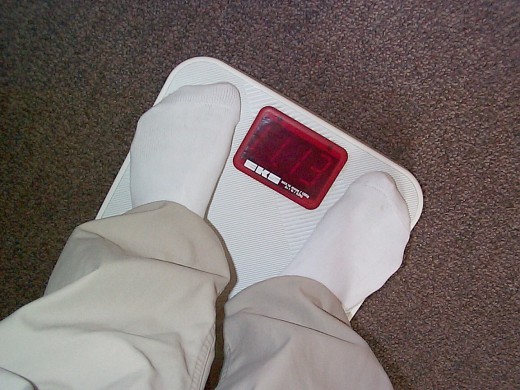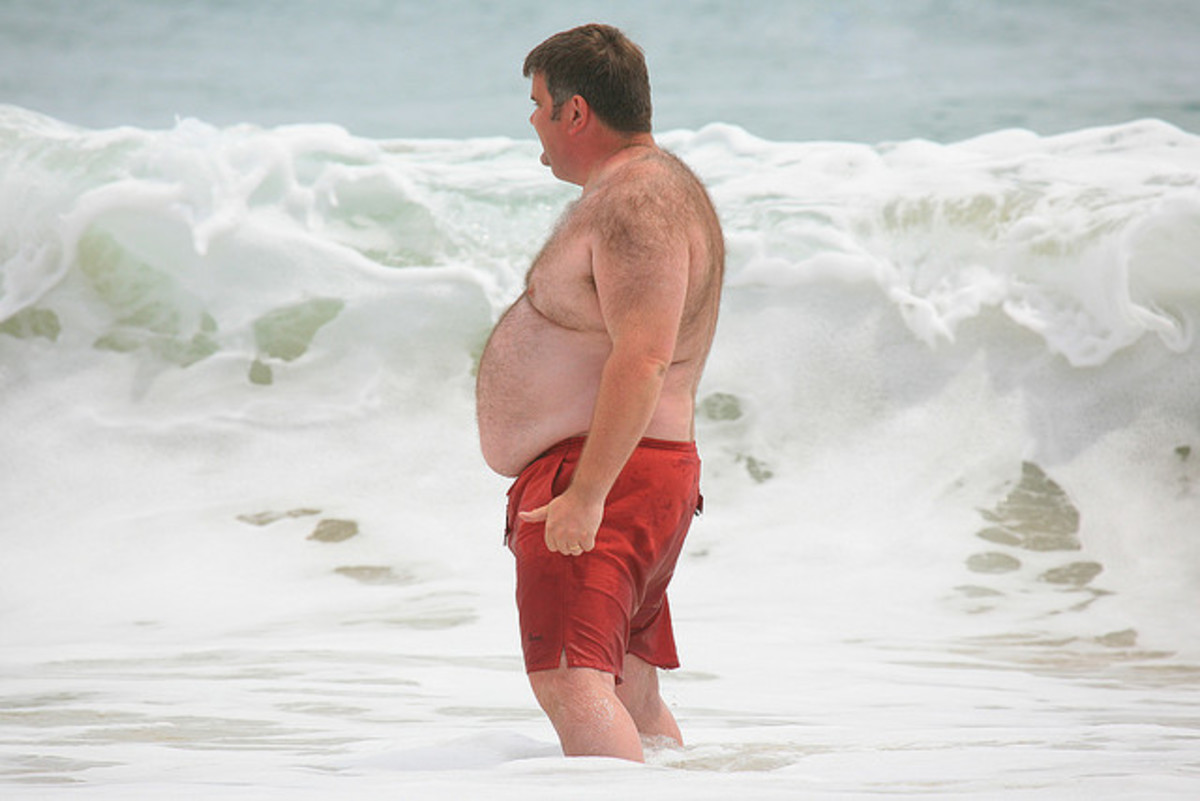Eat less, move more: The big, fat truth about weight loss
Weight loss is really simple when you break it down to the basics. It's all mathematics: you simply have to consume less calories than your body burns. But that doesn't mean it's easy! Trying to lose weight, especially those "last few pounds", can seem like an uphill battle, but if you eat fewer calories than you burn, you will lose weight.
As a society we are obsessed with weight loss, as is proven by the plethora of books, TV programs and websites all about weight loss. Many of us, myself included, have spent a fortune on a gym membership we haven't used. And who hasn't tried one of those crazy fad diets? We all want to lose 10 pounds in a week, but it's about time we realize that if it sounds too good to be true, it probably is.

The facts
- The medical community say that a 1-2 pound weight loss per week is healthy.
- The recommended calorie intake is 2000 kcal/day for women and 2500 kcal/day for men, but older and more sedentary people will require less energy.
- In order to lose 1 pound in a week, you have to consume 3500 calories fewer than you burn - this means a 500 calorie reduction per day (on average) compared to the above figures.
- This calorie reduction can be split between diet and exercise - for instance you could walk for around 45 minutes at 3.5 miles/hr and burn around 250 calories, and then reduce your energy intake by 250 calories below the recommended level, totalling 500 calories per day.
Read more about weight loss
- How to lose weight now...and keep it off!
Simple yet life-changing habits I have developed over the years and which have helped me, personally, to lose weight and keep it off; including my own "before/ after" photos which will inspire anyone! - Healthy Diet & Weight Loss
Are you overweight and need a healthy diet plan? Did you know that being overweight is linked to many health issues? Discover how to lose weight and keep it off naturally. - Weight Loss Tips 101: Make Lifestyle Changes
Weight Loss Tips 101: Make Lifestyle Changes is a hodgepodge of weight loss tips that have worked over the years for my friends and or me in achieving our weight loss regimens. The purpose of this hub is to...
Eat less
Eating less is often the most difficult part of a weight loss plan. You don't have to count every single calorie to succeed in this part of your weight loss plan. Just have a general idea of how many calories are in your basic foods, and try to keep it to the recommended level. If you check the labels on the foods you eat and cook recipes that have low calories, you will eventually develop a good idea of the calories in your foods without having to count.
- Banana (1 large) - 135 calories
- Potato chips (1 serving - 1 oz / 28 g) - 139 calories
- Roasted chicken, no skin (1 serving - 1 cup / 140 g) - 234 calories
Food is often linked to emotions, so stress can lead to eating too many calories. In order to become more healthy it is important to be conscious of what you are actually consuming, but also to be more positive about yourself and your choices.
Here are some tips that I found useful in my own weight loss journey:
- Don't think of it as a "diet". Just change what you eat every day so that it includes fewer calories in a way that fits in with your lifestyle. This change in mindset will make you more positive about what you eat. Think of some easy fixes that work for you; drink more water, increase your fiber intake to feel more full, cut out alcohol on week nights, eat fewer fried foods, swap chips and sweets for healthier snacks, or eat smaller meals.
- Eat slowly and resist the urge to go for that second helping. It takes your body around 10 minutes to send the signal to your brain that you are full, so try to wait a while to see if you really are still hungry. If you want more of something really delicious, just remember that if you don't eat it all now you can enjoy it again the next day. One easy way to keep your portion sizes down is to use a smaller plate - this really makes difference to how much you eat.
- Write down everything you eat. Writing down everything you eat makes you recognize exactly what you're eating - you might be surprised how much you really eat. Plus, if you're still gaining weight, later on you can look back at what you've been eating and make adjustments. You could also try using a tool like a website or iPhone application to calculate your calorie consumption and exercise and do the work for you, like Fitday.com or the iPhone app "Lose It!" (both are free) - it just takes some effort to input all of the foods you eat and exercise you do.
- Don't eat the same thing every day. Some dietary professionals will say that reducing the variety in your diet makes you eat less. Common sense says that not only is it incredibly boring to eat the same thing all of the time, but you probably won't get a good range of vitamins, minerals and all that other nutritional stuff. Also, I have noticed that varying my calorie intake slightly from day to day results in more consistent weight loss - probably because eating more calories on some days stops your body from going into starvation prevention mode.
- Follow the 80 - 20 rule. Eat healthily 80% of the time, but allow yourself some freedom the other 20% of the time. Not depriving yourself will help you to feel that you're not on a diet - perhaps eat healthily on weekdays and then spoil yourself a bit on the weekend. Don't make any foods taboo, because this may make you want them even more. Most importantly - don't panic! If you eat a doughnut, that doesn't mean the whole day is a write off and you can eat a plate of fries and a pint of ice cream. Accept that it's okay to indulge every now and then - you just have to try to eat a bit less for the rest of the day (or the next day) to make up for it.
Move more
There are 2 basic types of exercise: strength training and cardiovascular exercise. Any exercise is good, but if what you want is simply to shed the pounds, then cardiovascular exercise is the thing for you. This means running, cycling, and walking - exercises that really get your blood pumping. These exercises won't build much muscle - they just allow your body to burn energy (calories). Strength training - like lifting weights - is designed for building and toning muscle. Muscle weighs more than fat, BUT it also burns more calories. Therefore, if you build more muscle, then you will burn more calories even when you are at rest. Exercise (of any kind) has also been shown to help suppress your appetite. I believe that a sustainable weight loss plan includes both cardio and strength training.
Calorie burning per exercise depends largely on your weight, but here are some approximate figures for 1 hour of exercise for a 160 pound person (for more information, see the Mayo Clinic web site)
- Aerobics, high impact - 500 calories/hr
- Golf, carrying clubs - 325 calories/hr
- Walking, 3.5 mph - 275 calories/hr
If you're "exercise-phobic" like many people are, then you will need to find ways to make exercise more attractive to you. Making exercise part of your daily life is the key to accomplishing this. Not all of us can go to the gym or do traditional exercise every day, so we have to find other ways to burn those calories. Changing the way you do everyday things is a good way to succeed; if you drive to work, you could try walking or cycling, or even parking at the far end of the parking lot; if you play video games, try out some Nintendo Wii or Kinect for XBox 360 games. Another great idea is trying out a new activity that you think you will enjoy - like joining a local sports league, getting your friends together to go for walks, or even taking up gardening. Every bit of extra activity counts, so get up off the couch and get moving.
Bringing it all together
So, by now you know the basics and you have some helpful hints on how to eat less and how to move more, but there are a few extra tips that will help you to succeed.
- Set an achievable goal with a deadline. If you want to lose pounds, then aim to lose a maximum of 1-2 pounds a week. You can also set goals in terms of general fitness, inches around the waist/chest/legs, or simply the number of times you exercise per week. Choose a goal that works for you, and be positive about achieving it.
- Weigh yourself at least once a week. This is an easy way to keep track of whether or not whatever you are doing for weight loss is working. If your weight goes up or doesn't go down for a few weeks running then you probably have to tweak your diet or exercise regimen.
- Have fun! Don't make it too serious or you will have difficulty sustaining your new lifestyle.
Check out some other hubs by Chirls:
- How to make great soups
Whether it's for lunch or dinner, soup can be a delicious and satisfying meal. It's filling, comes in endless varieties, can be cheap and quick to make, and freezes and reheats easily. So why do people still... - How to cook 30 minute meals
Cooking may seem like a huge undertaking, but it doesn't have to be that way! It's possible to cook great tasting, healthy meals in 30 minutes, and I'm going to tell you how. - How to reduce food waste... and lower your grocery bill, too!
How many times have you gone to get something out of the veggie drawer and found half a celery wilting away at the bottom of it? Or you've gone into the fridge to get some milk, only to find that it's gone bad, and you have to pour it down the sink. - The truth about organic food
Organic food has become increasingly popular over the last few decades. Consumers are concerned about the health risks and environmental impacts associated with conventional grown foods, and have turned to... - Pulses, grains and the myth of complete proteins
Pulses and grains are a good source of protein, but if you're a meat-eater then you've probably never had to worry about getting enough protein in your diet. On the other hand, most vegetarians have probably had to endure the question "are you comple - A beginner's guide to making sushi
Eating out for sushi can be a great experience, but is often quite expensive. Making your own sushi is really fun and easy to do, and might save you money. - How to cook quick and healthy meals in 5 easy steps
In recent years, our relationship with food has changed. These days people are much more likely to eat out or buy ready made meals than to cook from scratch. Read on to get some tips on how to cook healthy and tasty foods. - Is Earth Day still worthwhile?
After 40 years, is Earth Day still as meaningful as it once was? This article covers the history of the modern environmental movement, including Earth Day, and discusses whether or not Earth Day is still worthwhile.







